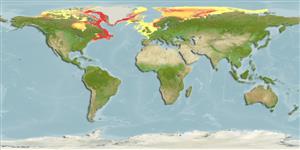分類 / Names
俗名 | 同種異名 | Catalog of Fishes(屬, 種) | ITIS | CoL | WoRMS | Cloffa
Teleostei >
Perciformes/Zoarcoidei (Eelpouts and pricklebacks)
鱸形目 (Eelpouts and pricklebacks) >
Zoarcidae (Eelpouts)
綿鳚科 (Eelpouts) > Lycodinae
Etymology: Lycodes: Greek, lykos = wolf + Greek, suffix, oides = similar to (Ref. 45335).
Environment: milieu / climate zone / depth range / distribution range
生態學
海洋 深海底的; 深度上下限 18 - 930 m (Ref. 117245). 深水域; -1°C - 4°C (Ref. 13534); 83°N - 41°N, 139°W - 141°E (Ref. 117245)
Western Atlantic: western Greenland (Ref. 4695), Hudson Bay and Labrador to Massachusetts (Ref. 7251). Arctic: west of Boothia Peninsula in the Northwest Territories (Ref. 3814) and the northern parts of Kara and Laptev seas (Ref. 4695).
西大西洋: 對麻薩諸塞州的格陵蘭 (參考文獻 4695) ,哈得遜灣與拉布拉多西部.(參考文獻 7251) 北極圈: 在喀拉海的西北地區 (參考文獻 3814) 與北部與 Laptev 海洋中的位於 Boothia 半島西方.(參考文獻 4695)
大小 / 重量 / 年齡
Maturity: Lm ? range ? - ? cm
Max length : 36.0 cm TL 雄魚/尚未辨別雌雄; (Ref. 7251)
Occurs on soft bottoms (Ref. 13534). Benthic (Ref. 58426). Feeds mainly on epibenthic animals and does not seem to burrow much for prey. Smaller fish prey on smaller species like amphipods, isopods and small bivalves while larger fish prey on shrimps, euphausiids and fish (Ref. 13532).
生活於軟質底部。 (參考文獻 13534) 底棲的.(參考文獻 58426) 主要吃淺海底棲動物而且似乎不為獵物多掘洞穴。 當較大的魚捕食蝦,磷蝦與魚的時候,較小的魚捕食像片腳類動物的較小種,等足目動物與小的二枚貝。 (參考文獻 13532)
Life cycle and mating behavior
成熟度 | 繁殖 | 產卵場 | 卵 | 孕卵數 | 仔魚
西大西洋: 對麻薩諸塞州的格陵蘭 (參考文獻 4695) ,哈得遜灣與拉布拉多西部.(參考文獻 7251) 北極圈: 在喀拉海的西北地區 (參考文獻 3814) 與北部與 Laptev 海洋中的位於 Boothia 半島西方.(參考文獻 4695)
Anderson, M.E., 1994. Systematics and osteology of the Zoarcidae (Teleostei: Perciformes). Ichthyol. Bull. J.L.B. Smith Inst. Ichthyol. 60:120 p. (Ref. 11954)
IUCN 瀕危狀態 (Ref. 130435: Version 2024-1)
人類使用
工具
特別的報告
下載 XML
網路資源
Estimates based on models
Preferred temperature (Ref.
123201): 1.4 - 7.1, mean 3.5 °C (based on 213 cells).
Phylogenetic diversity index (Ref.
82804): PD
50 = 0.5000 [Uniqueness, from 0.5 = low to 2.0 = high].
Bayesian length-weight: a=0.00309 (0.00192 - 0.00496), b=3.21 (3.07 - 3.35), in cm total length, based on LWR estimates for this species & Genus-body shape (Ref.
93245).
營養階層 (Ref.
69278): 3.5 ±0.53 se; based on food items.
回復力 (Ref.
120179): 低的, 最小族群倍增時間4.5 - 14 年 (Preliminary K or Fecundity.).
Fishing Vulnerability (Ref.
59153): Low to moderate vulnerability (26 of 100).
